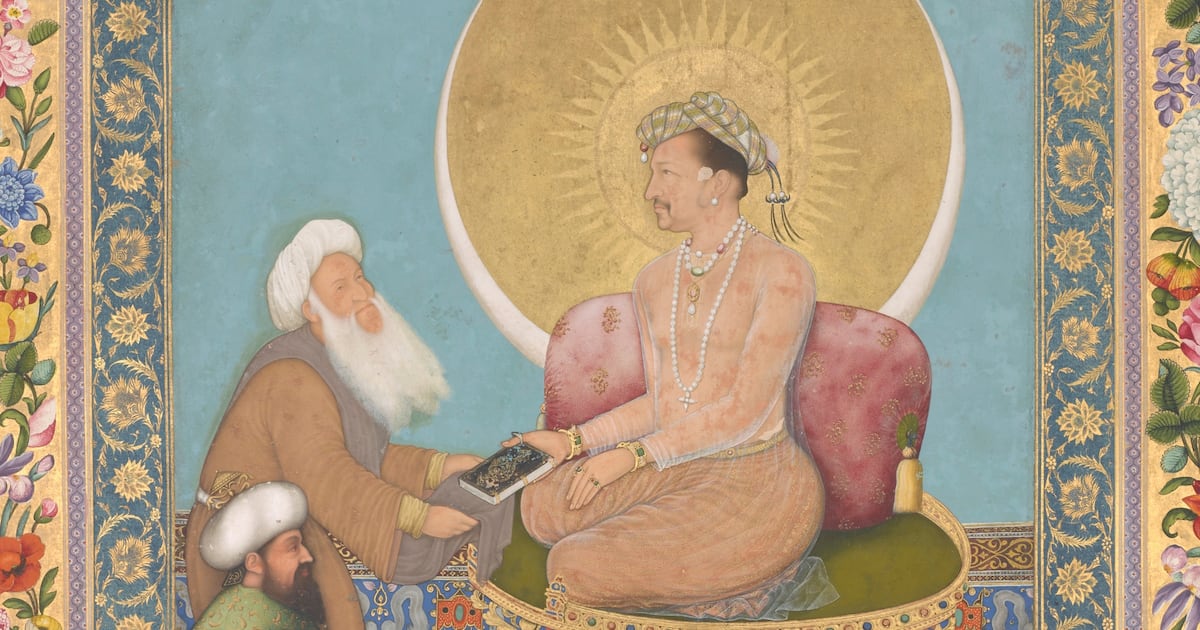A Mughal masterpiece by Bichitr in the Freer Gallery of Art trumpets spiritual values over worldly ones
[ad_1]
What explains the art market? How can we make sense of rich and powerful people spending so much surplus cash on small, portable things endowed with intangible values that even art critics struggle to articulate?
It’s simple, of course: A lot of rich people like art. They also realize – whether dimly or with the full force of revelation, it doesn’t matter – that there is more to life than accumulating wealth; that there are values we might call spiritual. They’re happy when visitors to their homes recognize they have grasped this.
Is skepticism warranted? Sure. A heavily insured signifier of spiritual depth is clearly not the same as spiritual depth. But there you have human nature, fretted with ironies.
In a spirit of positive reinforcement, subtly spiked with self-interest (when is motivation ever pure?), some of the best artists in history have made a point of reminding their wealthy patrons of the importance of otherworldly values. This early-17th-century watercolor from the Mughal court of Jahangir, which belongs to the Freer Gallery of Art, is a justly famous example.
It shows Jahangir, the great Mughal emperor and patron of the arts, sitting cross-legged on a throne that takes the form of a European hourglass. Beneath him are four people, slightly smaller in scale. The lower one is Bichitr, the artist who painted it. Above him are King James I of England, the Sultan of Turkey and – uppermost at left, the object of Jahangir’s rapt attention – Shaikh Hussain.
Shaikh Hussain was a Sufi descendant of the revered saint Khwaja Mu’in-ud-Din Chishti. It was to this saint’s shrine that the emperor Akbar once prayed for a son. Jahangir himself was the happy result.
One of the Persian couplets that appear in cartouches above and below states: “To all appearances, even as kings and potentates stand in attendance upon him, his gaze falls, inwardly, ever upon holy dervishes.” In other words, Jahangir – for all his immense worldly power, evoked by the magnificent jewels on his fingers and the transparent delicacy of his body-clinging jacket, or “jama” – knew what mattered.
What mattered was inner life, attendance upon the spiritual, represented both by Shaikh Hussain and by the exquisitely bound book which Jahangir proffers to the Shaikh, who respectfully receives it not with his hands but with the cradle he creates from his humble garment.
Such is the rhetoric behind “Jahangir Preferring a Sufi Shaikh to Kings.” It is an incredible thing, painted in infinitesimal brushstrokes that are themselves indices to the invisible, the sacred. The picture’s prevailing blue/yellow harmony is reinforced by the botanical border, added in the 18th century by Muhammad Sadiq, and enlivened within by green, red and orange. A Venetian-style carpet, rendered two-dimensionally and busy with incident, fills the lower half of the background. The upper half is an ethereal sky blue.
Jahangir’s head, in profile, with his slender almond eye sloping sagely down at the corner, his hint of a moustache and delicately twirled sideburn fuzz, is set against a disc-shaped nimbus that combines the sun and the moon.
Note, too, the four, pale-skinned putti, or cherubs. They’re a nod to those staples of European paintings, examples of which had been brought to the Mughal court by missionaries, merchants, and ambassadors. Bichitr was not trying to mimic European art so much as show his mastery of different styles within the same painting.
The two lower putti seem to be gathering the sand that falls through the hourglass, which is inscribed with a verse: “O Shah, may you live for a thousand years.” (The temporal theme has made B.N. Goswamy, the great scholar of Indian art, speculate that the work may have been painted and presented on the occasion of Jahangir’s birthday.)
Young Bichitr, in the lower left, appears to be holding up a painting for the emperor’s admiration. But even art, it turns out, fails to distract the spiritually attuned emperor.
Or so the artist would have us believe.
